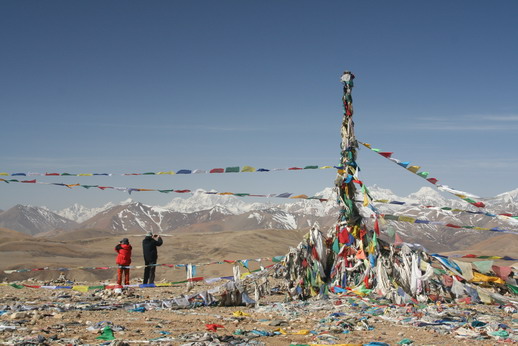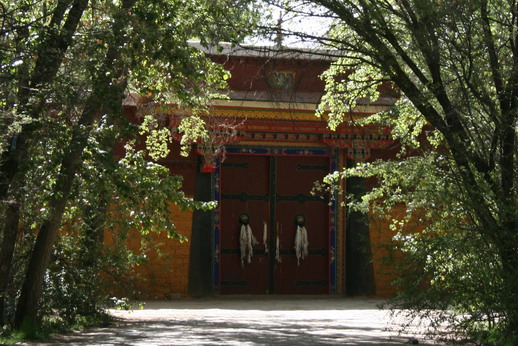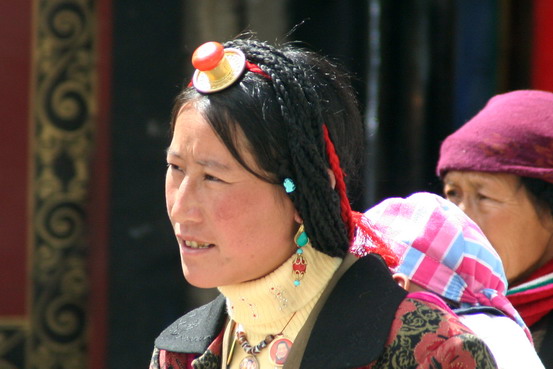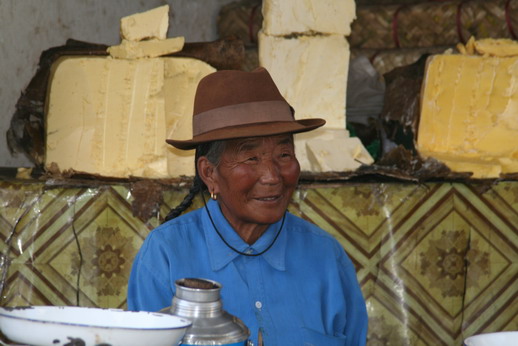
 Lalung La pass
(5050m)
Lalung La pass
(5050m)
 Dans le fond, le
toit du monde l'Everest, le Cho Oyu et le Makalu
Dans le fond, le
toit du monde l'Everest, le Cho Oyu et le Makalu








|
Note 99 Tibet Xangmu
to Lhassa: Where the mountains and the sky meet
28.04.07
After
all the panoramic posting the Potala's pixelized picture in
Nepal, I go to see
it in live.
To obtain a visa for Tibet, it is necessary
to pass by an agency and to travel by
group ( organized
tour). For the best, the "group" is
composed of 3 people; Erik, Czech and Zoltan, Slovak, who
squabble as Flemish
and Walloon, + me. organized
tour). For the best, the "group" is
composed of 3 people; Erik, Czech and Zoltan, Slovak, who
squabble as Flemish
and Walloon, + me.
Our Tibetan guide, Pempa, awaits us at Xangmu, the nepalo/chinese
border, in a
glowing Landcruiser (Zoltan is tour operator in Bratislava
and must be a
V.I.P.). The interior looks like a living room, striped
fitted carpet on the
seats and on the ground, and television by all the windows.
The road going from the Nepalese border to Lhassa, the Friendship Highway, is mythical. It crosses the Top
of the World with 3 peaks beyond 5000m.
1st stop in Nyalam (3750m). Surprised,
surprised, we are three in the room. Each one is nestling in
its sleepingbag, the temperature of the room going down
towards zero degree, without no other heating
that the slivovica, a house made plum
brandy, klobasa, Slovak salami and bread from over
there. I like this kind of organized trip.
29.04.07
Nyalam
There is a code of conduct in Tibet:
- not to show pictures of the Dalai Lama
- not to tackle with the Tibetans the sino/Tibetan
questions
- not to take part in a celest burial: the
body of the deceased is cut up, the bones are crushed and
the pieces are given to the vultures (I did not insist).
The road goes forward horizontally and
vertically, sending us to feel the frozen
breath of the Himalayas at the peaks of
Lalung La (5050m) and Tong (5200m) - 3850 m of difference in height since
Katmandou. I live again the rise of Thorung La, but sitting in a comfortable jeep
this time. The trees disappear gradually to leave place to a big desert,
rocky plateau. On the top, the pray flags touch the sky and whisper the mantras
through the wind. Each flag is like a satellite sending messages in the space.
Huge landscapes burned ground colours and ashy
grey, dominated by superlatives of
the tops, the Everest, (8848m-n°1), Lhotse
(8516m-n°4), Makalu (8485m-n°5) and Cho Oyu (8188m-n°6). We cross, without going,
the trail which joins the base camp of the Everest, on the north face.
Tingri The wool and salt merchants was
crossing this India-China axis formerly.
We stop in a caravanserai for a cup of salted butter
yak tea. Benches are arranged around the stove which functions with
dried shit of yak. And did you knew
it? Yak poo is worth much more as fuel that
cow poo (yak 10 Yuans the bag, cow 4 Yuans the bag). The yaks eat only good grass
of the high pastures whereas the
cows eat all what they find including
plastic. It does not smell so good when it burns.
30.04.07
Lhatse-Shigatse
The Czechs use 10 words when the English use
1! They keep this habit when they speak in English. A talk of slameur
rhythms my nomadic way; girls, beer, a
car wash job in Australia
the time to leatn english, a memory tattoo from
New Zealand, questions, projects, home or trip ....
02.05.07
Gyantse,
Gyantse is overhung by a fort which protects
the town. There is an anti-british memorial in the fort, the English having
attacked Gyantse in 1904, but not a word on the invasion of the Chinese in Tibet
(Oups my code of conduct).
I have since today a private room in a
typically Chinese hotel (= tiled floor, thermos, plastic sandals, set of tooth brush,
comb, small shampoos and television with 150 channels). I
ate
sweet-salted rice biscuits, watching the snooker world championship commented in
Chinese (Great ... but no need for words
to understand)... up to the power cut at 10
PM.
The Southern road continues towards the peaks
of Karo La (5200m) and Kamba La (4900m). The asphalted ribbon is held in a
lace which, seen top, looks like the Great Wall.
After a turn, a small incredibly
beautiful artificial lake of amilky green color with in the
centre appears
an abandoned stone-built house who overhangs a rock piton.
Our jeep then will circumvent Yamdrok Tso, a so high lake (4400m) with turquoise water supplied with
the molten snow of the high mountains.
It is not allowed to make photographs inside
the monasteries. I lose my means of capturing the memories but they are, in
short, the largest gompas, the oldest, the most important and the richest frescos.
|
 |
Tashilumpo at Shigatse: Panchen Lamas
residence and stupas. It houses a 26m high
Buddha of the Future statue, the biggest of
the country.
|
 |
Gyantse: the style is at the same time
Nepalese, Tibetan, Chinese. The most
patina.
|
 |
Jokhang in Lhassa. The oldest temple of Tibet
and the holiest of the country. |
 |
Drepung: the biggest monastic center of
Tibet. Populated formerly of 10000
inhabitants
|
 |
Norbulingka: the Summer Palace. The door by
which Dalai the LAMA escaped in
1959.
|
 |
Potala: the most monumental. Residence of
Dalai Lama, its entourage and a vast
monastic community.
|
03.05.07
Lhassa
03.05.07 Lhassa Considering the buildings
with the blue windows, the rococo palm trees street lights, the large tiled
esplanades, the disproportionate monuments at the glory of the Party, the
sounds/lignt/water shows in front of the Potala, the city is not prohibited any
more and the Chinese indeed gained the aesthetic control of the city.
But around Jokhang, the oldest monastery of
the city, the Buddhist feeling is so powerful that Lhassa seems
untouchable. The pilgrims of all the Tibet, the by far come nomads, the monks...
stroll without stop. They achieve the holy circles (Barkhor), making turn their
prayer wheel, prostrating, flapping their wood plates on the ground. The
offerings of incense and juniper berries burn and release walls of wreath
which wrap the monastery. And this spiritual intensity of the Tibetans makes
that Lhassa is really not a Chinese Las Vegas.
Faces of Barkhor:
                |
< |
 |
Thanks to Erik, because of who I am on 1 pix/ 2, "if not, it
is like postcard". We call him Brad Pitt (although he rather looks like the
last blond James Bond) for his mania to put his pumpkin (Czecho -slovakian
expression) in front of the
landscapes... Thanks to Zoltan whose the
backbag was full with unending
resources. I loved to make this trip with
them, 2 bon vivants, who like the good things of the life and
the journey, which taught me as much on Czech
Republic and Slovakia that I learned about Tibet.
On the way back, the wind and Air China carry
out me above the Himalayan giants, Kanchenjunga (8586m - n°3), the Everest and
Makalu. My Nepalese -Tibetan horizon had as for only
limit the 8 of 10 highest peaks of the world.
How many people are likely one day to paint
the color of their dream. This journey, where the sidereal tops and the sky
meet, has the color of my dreams.
For the questions relating to the situation
Tibetan:
to see
note de route 100 Dharamsala
Les
YYY
Y
Chang: a beer made with the excess of
barley. Fresh, sharp with the opaque color of yeast.
Y
To eat: the thantuk (soup of all, peas,
cabbages, pastes punts, carrots...), momos Tibetans (raviolis with the vapor
stuffed with vegetables, potatos, cheese...).
Y
To see: "7 years in Tibet", with Brad Pitt,
the Austrian mountaineer Heinrich Harrer meets in Lhassa the young person Dalai
LAMA with whom it binds friendship. "Kundun" history of XIVe Dalai
LAMA by Martin Scorsese.
Y
To read: The eye of Tibet, a polar of
Eliot Pattison, a Buddhist fiction
www.eliotpattison.com
Tingting and White Snow(Milou) in Tibet,
translated into Tibetan and Chinese
Y
a bar impossible not to go in Lhassa: Makye Ame
www.makyeame.cn
Y
the 10 highest mountain of the world
Cat tinetine,
reporter in Tibet,
5.5.07
|
|